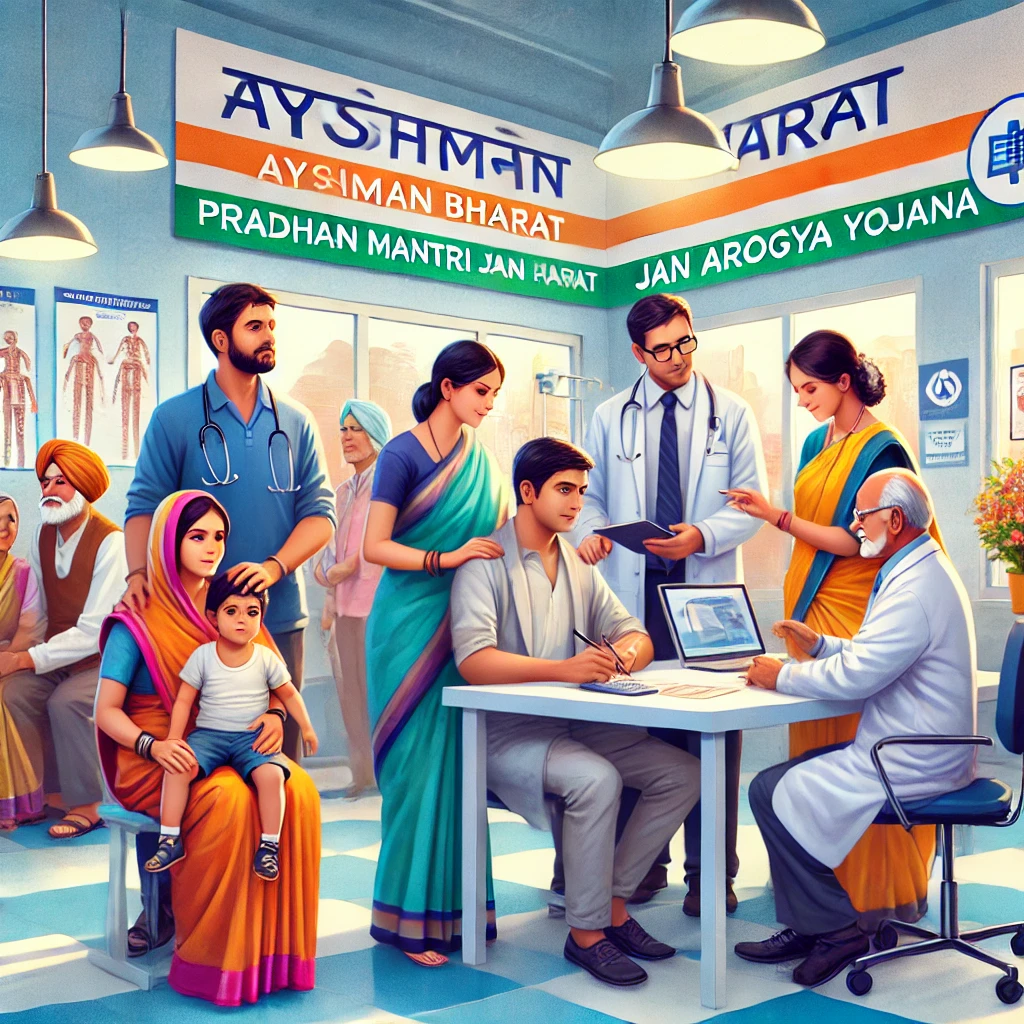Pradhan Mantri Jan Arogya Yojana (PMJAY) is a flagship health insurance scheme launched by the Government of India. Aimed at providing affordable healthcare to the underprivileged, this scheme has been transformative for millions. The initiative forms a critical part of the Ayushman Bharat Yojana, which focuses on providing comprehensive healthcare through preventive and promotional care.
- Launched in February 2018.
- Targeted at the economically vulnerable population.
- Covers hospitalization costs up to ₹5 lakh per family per year.

What is Ayushman Bharat Pradhan Mantri Jan Arogya Yojana (AB-PMJAY)?
The Ayushman Bharat Pradhan Mantri Jan Arogya Yojana (AB-PMJAY) is a national health protection scheme that aims to provide free access to healthcare for 40% of India’s population. Launched in 2018, this scheme is a part of the larger Ayushman Bharat initiative, which seeks to transform the primary, secondary, and tertiary healthcare landscape in India.
Key Features
- Health Coverage: Provides up to ₹5 lakh per family per year for secondary and tertiary hospitalization.
- Comprehensive Care: Covers almost all secondary and many tertiary hospitalizations, including pre and post-hospitalization expenses.
- Wide Network: Over 24,000 hospitals, both public and private, are empaneled under the scheme.
AB-PMJAY aims to alleviate the financial burden on the poor and vulnerable, ensuring that they receive necessary medical care without facing crippling costs.
What are the Eligibility Criteria for AB-PMJAY?
Eligibility for AB-PMJAY is primarily based on the Socio-Economic Caste Census (SECC) database. The scheme targets the economically disadvantaged, focusing on rural and urban populations who require significant medical support.
Rural Eligibility Criteria
- Household Criteria: Families without shelter, destitute, living on alms, manual scavenger families, primitive tribal groups, and legally released bonded laborers.
- Occupational Criteria: Scheduled Caste/Scheduled Tribe households, and families with no adult members between 16 and 59 years.
Urban Eligibility Criteria
- Occupation-Based Criteria: Individuals working as rag pickers, beggars, domestic workers, street vendors, cobblers, hawkers, and other manual labor occupations.
- Family Conditions: Families with only one room with kucha walls and roof, no adult male member, disabled members with no able-bodied adult member.
What are the Benefits of AB-PMJAY?
The Pradhan Mantri Jan Arogya Yojana offers numerous benefits that have significantly impacted India’s healthcare landscape. These benefits are designed to ensure comprehensive and accessible healthcare for all eligible beneficiaries.
Financial Protection
- Cashless Transactions: Beneficiaries can avail of cashless healthcare services at any empaneled hospital.
- Coverage Limit: Up to ₹5 lakh per family per year, covering all members of the family without any restriction on family size.
Comprehensive Coverage
- Wide Range of Services: Includes nearly 1,500 medical packages covering surgery, medical, day care treatments, cost of medicines, and diagnostics.
- Pre-Existing Conditions: All pre-existing conditions are covered from day one of the policy.
Improved Access to Quality Healthcare
- Empaneled Hospitals: Over 24,000 hospitals across India, including private and public hospitals, are part of the network, ensuring widespread access.
- Free Treatment: Beneficiaries receive treatment without paying a single rupee, reducing out-of-pocket expenditure significantly.
These benefits collectively ensure that the scheme not only addresses immediate healthcare needs but also fosters long-term health security for vulnerable populations.
Need for Ayushman Bharat Scheme
The Ayushman Bharat Scheme, and specifically the Pradhan Mantri Jan Arogya Yojana, addresses critical gaps in the Indian healthcare system. The need for such a comprehensive scheme arises from various socio-economic and healthcare-related challenges faced by the country.
Addressing High Out-of-Pocket Expenditure
India has one of the highest out-of-pocket expenditures on healthcare globally. This often pushes families into poverty. PMJAY helps reduce this burden by offering free healthcare services to the most vulnerable sections of society.
Bridging Healthcare Access Gaps
- Urban vs Rural: There is a significant disparity in healthcare access between urban and rural areas. PMJAY aims to bridge this gap by providing coverage across the country, including remote and rural areas.
- Public vs Private: The scheme ensures that both public and private hospitals are part of the network, offering a wider choice for beneficiaries.
Strengthening Healthcare Infrastructure
The scheme also aims to strengthen the healthcare infrastructure by incentivizing private sector participation and improving the quality of care in public hospitals. This leads to an overall improvement in the healthcare system, benefiting the entire population.
What are the Challenges in Implementing PMJAY?
Despite its ambitious goals and significant benefits, the implementation of PMJAY faces several challenges. Addressing these challenges is crucial for the scheme to achieve its full potential.
Awareness and Outreach
- Lack of Awareness: Many eligible beneficiaries are unaware of the scheme and its benefits. Effective outreach and awareness campaigns are necessary to ensure that more people can benefit from the scheme.
- Geographical Barriers: Reaching remote and rural areas remains a significant challenge. Innovative approaches, such as mobile health units and digital platforms, are required to overcome these barriers.
Infrastructure and Capacity
- Hospital Network: While the scheme has a wide network of empaneled hospitals, the quality and capacity of these hospitals vary significantly. Continuous monitoring and quality assurance are necessary.
- Human Resources: There is a shortage of trained healthcare professionals, particularly in rural areas. Investment in training and retaining healthcare workers is essential.
Fraud and Abuse
- Preventing Fraud: Ensuring the integrity of the scheme and preventing fraud and abuse is a significant challenge. Robust monitoring systems and strict penalties are required to address this issue.
- Verification Processes: Efficient and accurate beneficiary verification processes are necessary to prevent misuse and ensure that the benefits reach the intended recipients.
Financial Sustainability
- Funding: Ensuring adequate and sustained funding for the scheme is critical. The government needs to allocate sufficient resources and explore alternative funding mechanisms.
- Cost Management: Controlling healthcare costs without compromising quality is essential for the long-term sustainability of the scheme.
Conclusion
In conclusion, while the Pradhan Mantri Jan Arogya Yojana has made significant strides in transforming healthcare in India, addressing these challenges is crucial for its continued success and sustainability. By overcoming these hurdles, the scheme can truly realize its potential of providing universal healthcare access to the most vulnerable populations in India.


